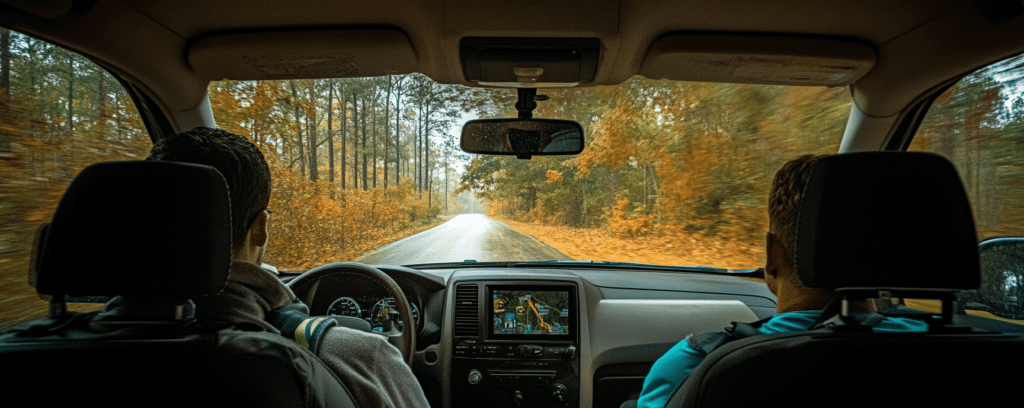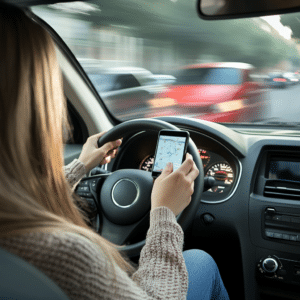
Curious about the odds of surviving a rollover car accident, one of the most severe types of motor vehicle crashes? Survival rates can vary based on seat belt use, vehicle design, and speed at the time of the crash. In this article, we’ll delve into factors that influence your chances and offer practical tips for staying safe.
Key Takeaways
-
Ejection during a rollover crash dramatically increases the risk of fatal injuries, with ejected occupants facing a five-fold higher mortality rate compared to those who remain inside the vehicle.
-
The design of a vehicle, including roof strength and safety features like electronic stability control, significantly affects survival rates in rollover accidents.
-
Seat belts and airbags are critical safety devices that greatly reduce fatalities and severe injuries in rollover incidents, with properly restrained passengers having much higher survival rates.

Hurt in an Accident? Hire Maguire
Hurt? You Need Our Help
Give us a call for a FREE & CONFIDENTIAL Case Review*
Definition and Causes of Rollover Accidents
A rollover accident is a type of motor vehicle crash where a vehicle tips over onto its side or roof, often resulting in serious injuries or fatalities. These accidents can be particularly devastating due to the violent nature of the rollover and the potential for occupants to be ejected from the vehicle. Understanding the causes of rollover accidents can help in preventing them.
Several factors can lead to a rollover accident:
- Driver Error: Speeding, reckless driving, or failing to maintain control of the vehicle are common causes. Sudden maneuvers, such as sharp turns or overcorrections, can also trigger a rollover.
- Vehicle Design or Manufacturing Defects: Vehicles with a high center of gravity, such as SUVs and pickup trucks, are more prone to rollovers. Inadequate roof strength can also contribute to the severity of these accidents.
- Road Conditions: Uneven or slippery surfaces can cause a vehicle to lose traction and rollover. Potholes, loose gravel, and poorly maintained roads are significant risk factors.
- Weather Conditions: Heavy rain, snow, or ice can make roads treacherous, increasing the likelihood of a rollover accident.
- Tire Blowouts or Mechanical Failures: A sudden tire blowout or other mechanical failure can cause a driver to lose control, leading to a rollover.
According to the National Highway Traffic Safety Administration (NHTSA), rollover accidents account for approximately 10% of all traffic fatalities in the US. The odds of surviving a rollover car accident are significantly lower than other types of car accidents, with a fatality rate of 38.8% compared to 17.4% for other types of crashes. This stark difference underscores the importance of understanding and mitigating the risks associated with rollover accidents.
Factors Influencing Survival in Rollover Crashes
Surviving a rollover crash, one of the most severe types of motor vehicle crashes is often a matter of inches and seconds. The risk of ejection is a major factor in survival. Ejection from the vehicle during a rollover event dramatically increases the risk of fatal injuries. In fact, ejected occupants face a five-fold higher mortality rate compared to those who remain inside the car. This is because ejected accident victims often sustain severe torso and head injuries from secondary impacts with the ground or other objects.
Vehicle type is another crucial factor in rollover crashes. SUVs, for instance, are 11 times more likely to roll over compared to passenger cars. This higher rollover risk is particularly concerning given that approximately 60% of children involved in rollover crashes are traveling in SUVs. Higher speeds also correlate with an increased likelihood of rollover incidents.
The design of a vehicle greatly affects survival outcomes in rollover accidents. Cars that maintain a larger survival space during a rollover event tend to have better outcomes for passenger vehicle occupants. Additionally, the number of complete rolls and the use of restraints like seat belts greatly influence the risk of severe head and thorax injuries.
Thus, understanding these factors can help you make informed decisions about vehicle choice and driving behavior, ultimately enhancing your chances of surviving a rollover crash.
Types of Rollover Accidents
Rollover accidents can be categorized into several types, each with unique characteristics and contributing factors. Understanding these types can help identify potential risks and take preventive measures.
- Single Vehicle Crashes: These occur when a vehicle rolls over without colliding with another vehicle or object. They are often the result of driver error, such as overcorrection or losing control on a slippery road.
- Multi-Vehicle Crashes: In these accidents, a vehicle rolls over after colliding with another vehicle or object. The impact from the collision can cause the vehicle to tip over.
- Tripped Rollovers: These happen when a vehicle rolls over after striking a curb, guardrail, or other object. The sudden impact can cause the vehicle to flip.
- Untripped Rollovers: These are less common and occur without the vehicle striking an object. They often result from high-speed maneuvers or sudden changes in direction.
- Roof Crush Rollovers: In these accidents, the vehicle’s roof collapses during the rollover, often resulting in serious head and neck injuries. This type of rollover highlights the importance of strong roof structures in vehicle design.
Rollover accidents can occur in any type of vehicle, but they are more common in vehicles with a higher center of gravity, such as SUVs and pickup trucks. The risk of rollover accidents can be reduced by choosing a vehicle with a rollover rating of 4 or 5 stars from the NHTSA, wearing seat belts, and using airbags. These safety measures can significantly enhance your chances of surviving a rollover accident and minimizing serious injuries.
Common Injuries in Rollover Accidents

Spinal cord injuries are another common and devastating outcome of rollover accidents. These injuries can lead to paralysis and loss of organ function below the injury site, drastically altering the accident victim’s quality of life.
Multiple broken bones are also frequent, often requiring extensive surgery and long recovery periods.
The violent nature of rollover crashes often results in severe cuts, scrapes, and bruises for passengers. These seemingly minor injuries can become serious if they lead to infections or other complications. Long-term effects of rollover injuries often include chronic pain, vision loss, and emotional difficulties, all of which can significantly impact daily living.
Awareness of these common injuries underscores the need for safety measures and proper vehicle maintenance to prevent rollover accidents. By being aware of the potential physical consequences, you can better appreciate the need for caution and preparedness on the road.

Car Accident Lawyer? Hire Maguire
Give us a call for a FREE & CONFIDENTIAL Case Review*
The Role of Seat Belts and Air Bags in Survival
Seat belts and airbags play a crucial role in enhancing survival rates in rollover accidents. Using seat belts is crucial in reducing fatalities. Seat belts significantly lower the chance of ejection and related injuries in rollover crashes. The majority of fatalities in rollover accidents involve unrestrained passengers, highlighting the life-saving potential of this simple device.
The statistics are stark: only 3% of completely ejected occupants were wearing seat belts at the time of the accident. This clearly shows that not wearing a seat belt is a significant risk factor in rollover accidents. Proper seatbelt restraint helps control occupant movement, significantly reducing the chance of severe injury or ejection.
Curtain airbags, in particular, can mitigate the severity of injuries in rollover accidents. When deployed, airbags provide an additional layer of protection, cushioning the impact and preventing occupants from striking hard surfaces inside the vehicle. Seatbelt use, combined with curtain airbag deployment and other safety design features, is critical in preventing occupant ejection.
Using both seat belts and airbags highlights their importance in vehicle safety design and their life-saving role during crashes. Consistent use of these safety devices is essential in reducing fatality rates in rollover incidents.
Vehicle Design and Its Impact on Crash Survival
The design of a vehicle is pivotal in determining the outcome of rollover crashes. Roof strength is a crucial aspect of vehicle design. A stronger roof can significantly reduce the severity of injuries, including traumatic brain injury, sustained during a rollover, as it is less likely to collapse and compromise the survival space inside the vehicle.
Advanced safety features in modern vehicles enhance survival chances in rollover accidents. These include Electronic Stability Control (ESC), which helps prevent rollovers by improving vehicle stability and control. Keeping up with safety regulations and ensuring your vehicle has modern features can greatly enhance occupant safety.
Recognizing the importance of vehicle design in crash survival emphasizes the need to consider safety features when buying a new car. By choosing vehicles with robust safety features, drivers can significantly reduce the risk of fatal injuries in the event of a rollover crash.
Statistics on Rollover Accident Fatalities
Rollover accident statistics are sobering and highlight the severity of these motor vehicle crashes. Rollover crashes account for nearly one-third of fatalities among vehicle occupants on highways. In the United States, rollover accidents are responsible for about 20% of all fatal crashes each year.
Rollover accidents cause over 10,000 deaths annually, with a mortality rate of 3.4 per 100,000 persons in the US. A significant proportion of these fatalities, approximately 66%, involved individuals who were ejected from the vehicle. The risk of mortality for occupants ejected during a rollover crash is five times higher than for those who remain inside the vehicle.
Single-vehicle rollovers are particularly deadly, accounting for nearly half of all rollover occupant deaths in 2019. SUVs, due to their higher center of gravity, are involved in approximately 37% of all fatal rollover incidents. Even commercial trucks are not immune, with about 4% of all deadly accidents involving tractor-trailers attributed to rollovers.
These statistics underscore the critical importance of safety measures, vehicle design, and responsible driving behaviors in preventing rollover fatalities. By understanding the risks and implementing safety precautions, we can work towards reducing the number of fatal rollover accidents.
Preventing Rollover Accidents

Overcorrecting or panicking while driving can lead to a loss of control and potential rollovers. High speeds significantly increase the likelihood of a rollover during an accident. Regular tire checks and maintenance are crucial, as worn tires can impair vehicle control.
Vehicles, especially SUVs and pickup trucks, should not be overloaded, as increased weight can reduce stability. Caution on rural highways, common sites for fatal rollovers due to higher speed limits, is also important.
Following these measures can greatly reduce rollover risks and ensure safer journeys for drivers and passenger vehicles.
Legal Assistance After a Rollover Accident
Seeking legal assistance after a rollover accident is crucial for recovery and financial compensation. An attorney can handle insurance interactions, ensuring your rights are protected and minimizing the risk of exploitation.
Many personal injury attorneys work on a contingency fee basis, requiring payment only if the case is won. This arrangement makes legal help more accessible for accident victims facing significant medical bills and other expenses.
Hiring a personal injury attorney can greatly enhance the chances of fair compensation after a rollover accident. Legal experts can navigate insurance claims and legal proceedings, allowing accident victims to focus on recovery.
Frequently Asked Questions
What are the most common injuries in rollover accidents?
In rollover accidents, the most common injuries are head and neck injuries, traumatic brain injuries, spinal cord injuries, broken bones, and severe cuts. These injuries can have significant, long-lasting effects on a person’s health and well-being.
How do seat belts and airbags help in rollover accidents?
Seat belts are crucial in preventing ejection and maintaining control during a rollover, while airbags offer essential cushioning that reduces the severity of injuries. Together, they significantly enhance occupant safety in such accidents.
Why are SUVs more prone to rollovers?
SUVs are more prone to rollovers due to their higher center of gravity, which increases the risk of tipping over during sharp turns or sudden maneuvers. This design factor highlights the importance of careful driving in SUVs.
What should I do to prevent a rollover accident?
To prevent a rollover accident, focus on avoiding distracted driving, maintaining control of your vehicle, regularly checking tire conditions, and ensuring you do not overload your vehicle. Implementing these practices will greatly enhance your safety on the road.
How can a personal injury attorney help after a rollover accident?
A personal injury attorney can effectively manage insurance claims and safeguard your rights, ensuring you receive fair compensation for your injuries and losses from a rollover accident. Their expertise is crucial in navigating the complexities of your case.
Last updated Tuesday, February 4th, 2025




